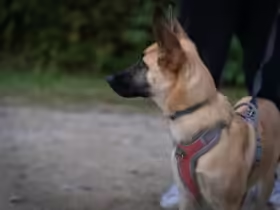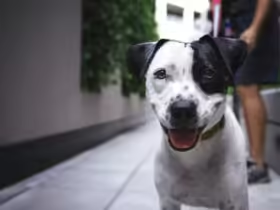Incontinence in senior dogs is a common issue that can be both challenging and distressing for both the dog and the owner. As dogs age, they may lose some control over their bladder or bowel functions due to a variety of reasons, including medical conditions, aging muscles, or even cognitive decline. While it can be difficult to manage, there are ways to help your senior dog deal with incontinence and improve their quality of life. In this blog, we’ll explore the causes, management strategies, and solutions to help you care for your senior dog with incontinence.
Understanding Incontinence in Senior Dogs
To effectively manage incontinence, it’s essential to understand the underlying causes and symptoms:
- What Is Incontinence? Incontinence refers to the involuntary loss of urine or feces. It’s different from house soiling, where a dog consciously relieves itself indoors due to a behavioral or training issue. Incontinence in senior dogs can manifest as dribbling urine, wet spots where the dog has been lying down, or a complete loss of bowel control.
- Common Causes:
- Urinary Tract Infections (UTIs): Infections can irritate the bladder, leading to frequent and uncontrollable urination.
- Hormonal Imbalances: Conditions like estrogen-responsive incontinence, often seen in spayed female dogs, can cause weakening of the urethral sphincter.
- Weakened Muscles: As dogs age, the muscles that control the bladder and bowels may weaken, making it harder for them to control their bodily functions.
- Spinal or Neurological Issues: Conditions like degenerative myelopathy or spinal cord injuries can disrupt nerve signals to the bladder.
- Cognitive Dysfunction: Similar to dementia in humans, cognitive dysfunction in dogs can affect their ability to recognize when they need to go outside.
1. Consult Your Veterinarian
The first and most crucial step in managing incontinence is to consult your veterinarian:
- Diagnosis: A vet can determine the underlying cause of your dog’s incontinence through physical exams, blood tests, urinalysis, and imaging studies. Identifying the root cause is key to developing an effective treatment plan.
- Treatment Options: Depending on the cause, your vet may prescribe medications, hormone therapy, or suggest lifestyle changes to manage the condition. In some cases, surgery might be an option to correct anatomical issues.
- Regular Check-Ups: Regular veterinary visits are essential to monitor your dog’s condition and adjust the treatment plan as needed.
2. Medications for Incontinence
Several medications can help manage incontinence in dogs:
- Hormone Replacement Therapy: For dogs with hormone-responsive incontinence, especially spayed females, hormone replacement therapy using drugs like DES (diethylstilbestrol) or phenylpropanolamine can strengthen the urethral sphincter.
- Antibiotics: If a urinary tract infection is the cause, a course of antibiotics can clear up the infection and reduce incontinence.
- Medications for Bladder Control: Drugs like phenylpropanolamine (Proin) are commonly prescribed to increase the tone of the urethral sphincter muscle, helping to reduce urine leakage.
- Pain Management: If spinal or neurological issues are contributing to incontinence, pain management medications may be prescribed to improve your dog’s mobility and comfort.
3. Dietary Adjustments
Diet can play a role in managing incontinence and supporting overall urinary health:
- Increase Fiber Intake: Adding fiber to your dog’s diet can help regulate bowel movements and reduce the risk of fecal incontinence. Pumpkin, sweet potatoes, or fiber supplements designed for dogs are good options.
- Specialty Diets: Some commercial dog foods are formulated to support urinary health, particularly for dogs prone to urinary stones or infections. These diets can help maintain a healthy urinary tract and prevent issues that may lead to incontinence.
- Hydration: Ensure your dog is well-hydrated, as dehydration can concentrate urine and exacerbate incontinence. Fresh water should always be available, and you may consider adding wet food to their diet to increase fluid intake.
4. Manage Your Dog’s Environment
Making adjustments to your home can help manage incontinence and keep your dog comfortable:
- Protective Bedding: Use waterproof or washable dog beds to prevent urine from soaking through. Consider placing absorbent pads or liners under the bed for added protection.
- Accessible Potty Areas: Make it easy for your dog to relieve themselves by creating accessible potty areas. If your dog struggles with mobility, consider placing a potty pad near their bed or using an indoor dog potty.
- Regular Breaks: Increase the frequency of bathroom breaks, especially after meals, naps, or long periods of inactivity. Senior dogs may need to go outside more often to prevent accidents.
- Block Off Certain Areas: If your dog has a specific area where they are more prone to accidents, consider using baby gates or barriers to restrict access.
5. Use Incontinence Products
There are a variety of products available to help manage incontinence in senior dogs:
- Dog Diapers: Diapers are one of the most effective ways to manage incontinence. There are disposable and washable options available, designed specifically for male and female dogs. Make sure to choose the right size for your dog’s comfort.
- Belly Bands: For male dogs, belly bands can be used to manage urinary incontinence. These wraps fit around your dog’s midsection and hold an absorbent pad in place to catch urine.
- Absorbent Pads and Liners: Place absorbent pads or liners in your dog’s bed or favorite resting spots to catch any accidents and protect furniture or flooring.
6. Maintain a Regular Grooming Routine
Incontinence can lead to hygiene issues, so maintaining a regular grooming routine is important:
- Frequent Bathing: Bathe your dog regularly to keep their skin and coat clean. Pay special attention to the genital area, where urine or feces may accumulate and cause irritation or infection.
- Wipe-Downs: Use pet-safe wipes to clean your dog’s genital area between baths, especially after accidents, to prevent irritation and odor.
- Monitor for Skin Issues: Incontinence can lead to skin problems such as rashes, infections, or hot spots. Keep an eye on your dog’s skin and consult your vet if you notice any redness, swelling, or sores.
7. Consider Alternative Therapies
Alternative therapies can complement traditional treatments and help manage incontinence:
- Acupuncture: Acupuncture can help strengthen bladder control by stimulating nerves and muscles involved in urinary function. Many holistic veterinarians offer acupuncture as a treatment option.
- Herbal Remedies: Certain herbal remedies, such as corn silk or saw palmetto, are believed to support urinary health and may help manage incontinence. Always consult your vet before trying any herbal treatments.
- Chiropractic Care: For dogs with spinal issues contributing to incontinence, chiropractic adjustments may help improve nerve function and bladder control.
8. Exercise and Physical Therapy
Keeping your senior dog active can support muscle tone and overall health:
- Gentle Exercise: Regular, low-impact exercise like short walks or swimming can help maintain muscle strength, including the muscles that control bladder and bowel function.
- Physical Therapy: Consult a veterinary physical therapist who can provide exercises and therapies to strengthen your dog’s core and pelvic muscles, which are crucial for maintaining continence.
- Weight Management: Keeping your dog at a healthy weight reduces pressure on the bladder and other organs, which can help manage incontinence.
9. Provide Emotional Support
Incontinence can be distressing for your dog, so it’s important to provide emotional support:
- Stay Calm and Patient: Avoid scolding your dog for accidents, as this can lead to anxiety and worsen the problem. Instead, calmly clean up accidents and provide reassurance.
- Create a Safe Space: Designate a comfortable, quiet area where your dog can rest without fear of accidents. Use absorbent materials and keep the area clean and inviting.
- Positive Reinforcement: Encourage your dog with praise and treats when they manage to go outside or use their designated potty area. Positive reinforcement can help build their confidence.
10. Plan for Long-Term Care
Incontinence may be a lifelong issue for some senior dogs, so it’s important to plan for their long-term care:
- Caregiver Support: If you’re unable to be home with your dog during the day, consider enlisting the help of a pet sitter or dog walker to provide regular bathroom breaks.
- Monitor Progress: Keep track of your dog’s incontinence episodes and any changes in their condition. Share this information with your vet during check-ups to adjust their treatment plan as needed.
- End-of-Life Considerations: For dogs with severe incontinence and other age-related issues, discuss end-of-life care options with your vet. They can help you assess your dog’s quality of life and make compassionate decisions when the time comes.
Conclusion
Dealing with incontinence in a senior dog can be challenging, but with the right approach, you can help your dog live comfortably and with dignity. From veterinary care and medications to lifestyle adjustments and emotional support, there are many ways to manage incontinence and improve your dog’s quality of life. Remember, your patience and understanding are key to helping your senior dog through this stage of their life.











Leave a Reply